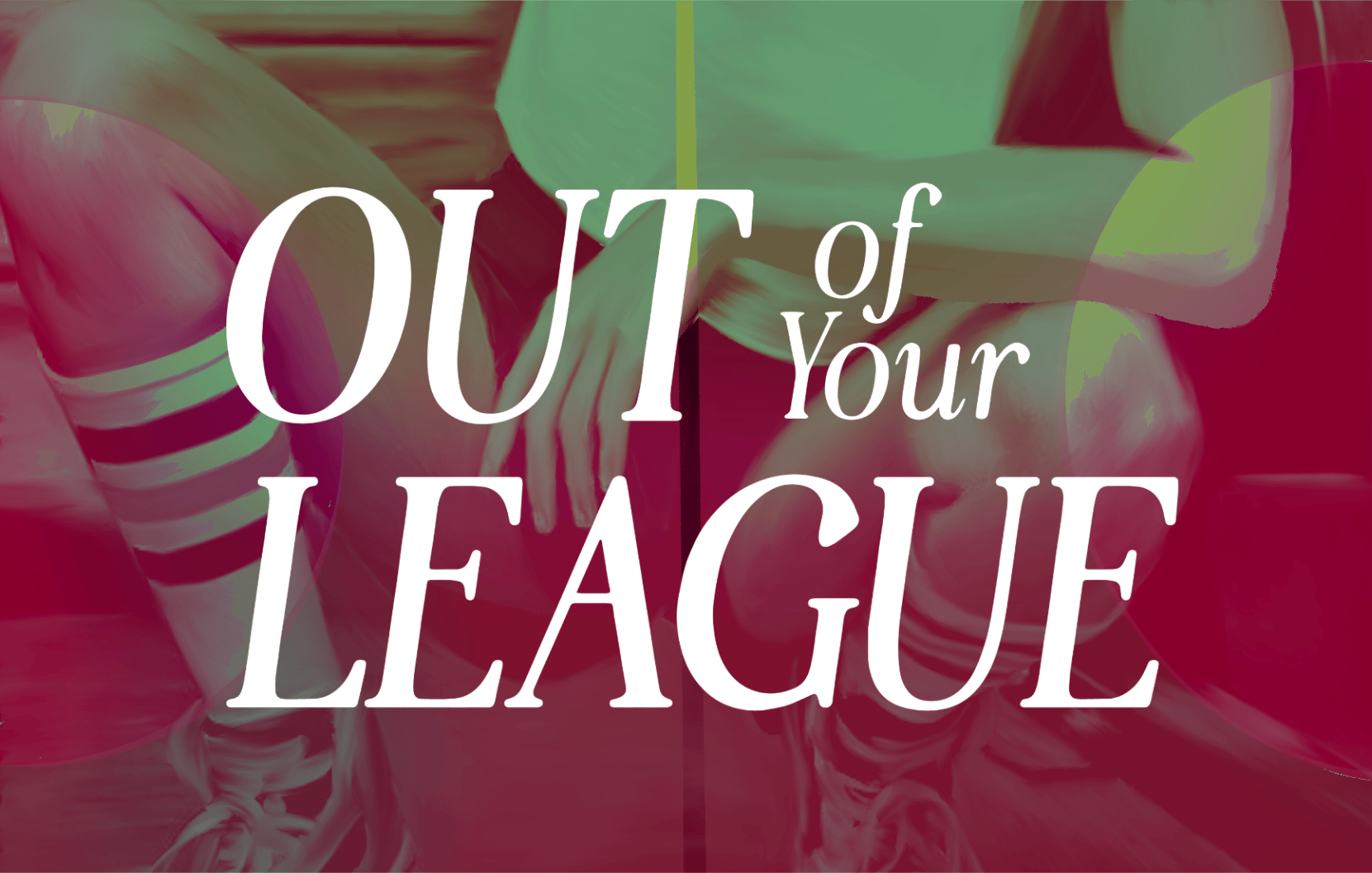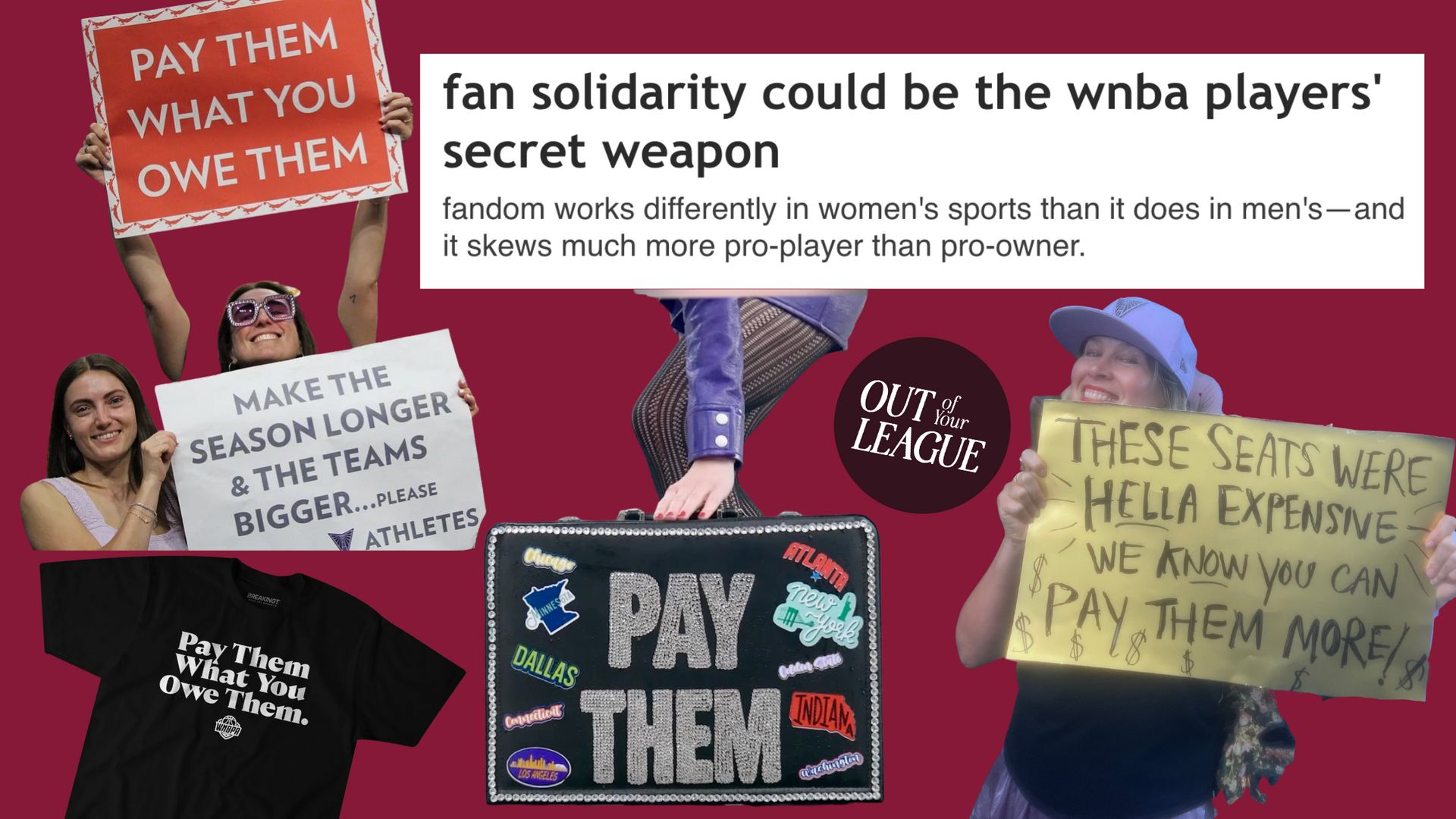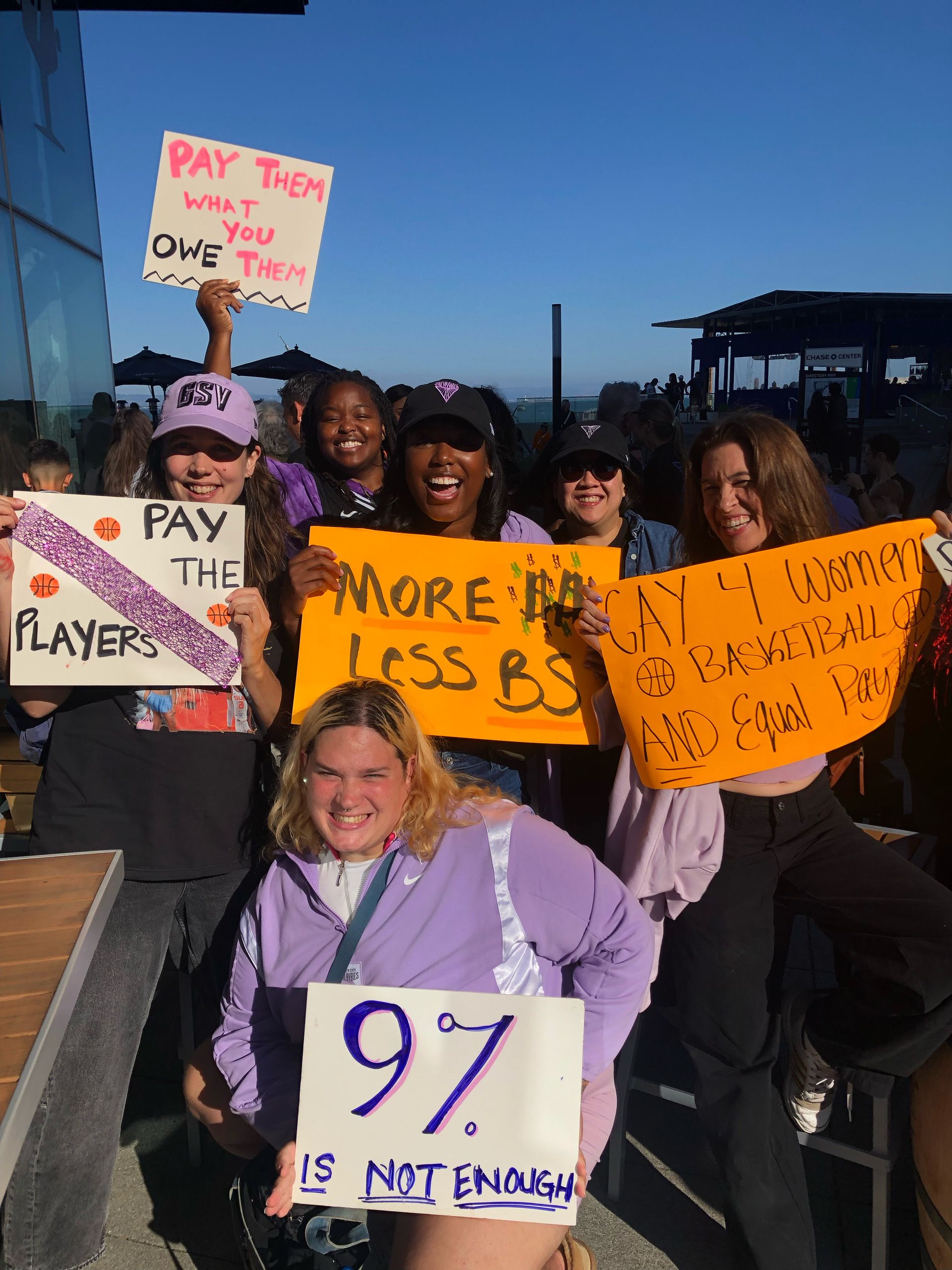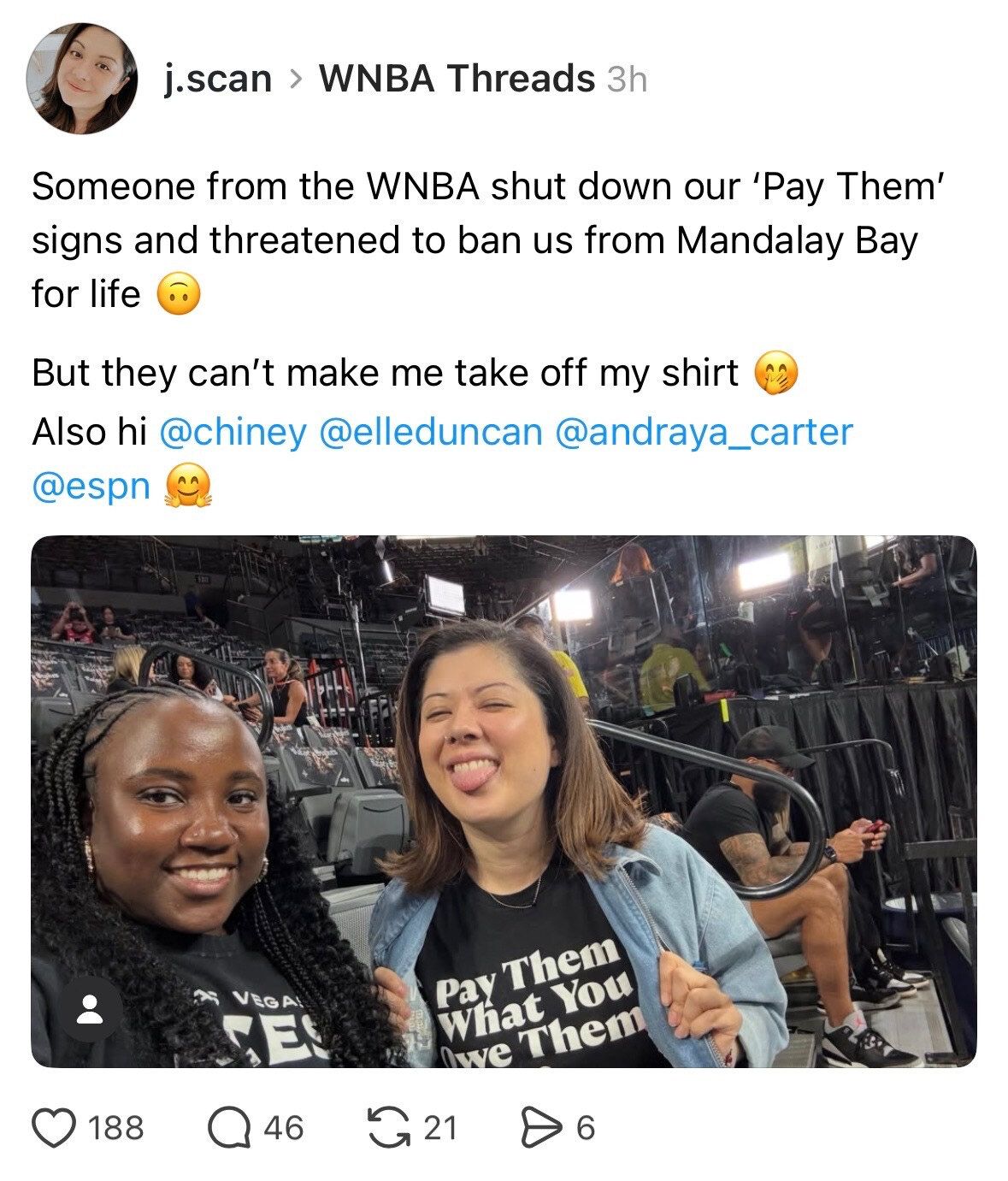
Thank you so much for being here! I am a full-time freelance writer and paid subscriptions to this newsletter allow me to continue to do work like this, as well as hiring an editor for longer, more involved posts (like this one!). This post is free to read, but a lot of reporting and time went into it—it was rejected by several women’s publications for being “too inside baseball,” because I guess workplace rights and pay equity aren’t issues women are concerned with. Your support allows me to continue writing stories like this even when establishment media doesn’t see its value.
A paid subscription also supports the community that we are building here, which includes events like the Out of Your League Book Club and our (very active) paid subscriber Discord server. You can upgrade here:

On Oct. 10, WNBA Commissioner Cathy Engelbert stood on the Mortgage Matchup Center court in Phoenix, Arizona and presented the Las Vegas Aces with their third championship trophy in just four seasons. As Engelbert spoke into the microphone, her speech was drowned out by fans booing. ESPN even had to censor fans on the broadcast who were showing her their middle fingers. Behind Engelbert, Aces players stifled their laughs.
While unpopular league commissioners are nothing new in professional sports, the jeering that Engelbert received was particularly pointed. WNBA players were (and still are) in the middle of negotiating a new Collective Bargaining Agreement with the league, and those negotiations have become tense as the Oct. 31st deadline approaches—a deadline that now seems unlikely to be met. Booing Engelbert is just one way that WNBA fans have gone out of their way to support the players in their labor fight.
In many ways, WNBA fans (and other women’s sports fans) are uniquely supportive of athlete labor rights — especially, in this case, for pay equity and better working conditions. While fans can't provide much direct help, the Women’s National Basketball Players’ Association (WNBPA) may be more likely to enact a work stoppage if it thinks fans will support it. And the PA has good reason to believe in its fanbase.
“I am all for [WNBA players] doing whatever they need to do to get a deal that's fair for them,” says Katie Miles, a WNBA fan and labor organizer from San Francisco. “I can't think of a single fan I've talked to who feels differently. I think fans would really support the players taking whatever action they think is necessary.”
Ever since players handed out “Pay Us What You Owe Us” signs at All-Star Weekend, fans have accepted the invitation to show their solidarity. And Miles, alongside a large contingent of fellow fans, has made sure that WNBA leadership hears her voice. From making signs at pre-game parties, to wearing their politics across their chest, to delivering a suitcase full of signatures directly to Engelbert, fans are speaking up and showing out in ways that league management likely never anticipated.
“Fans expand the arena of negotiation,” Erin Drake, Senior Advisor and Legal Counsel for the WNBPA, tells Out of Your League. “The CBA isn’t just a document; it’s a statement of values. When fans demand better conditions and better pay for players, it tells the league and our partners that this movement has public momentum. It also defines the scope of what is and is not acceptable… That kind of public accountability can shift outcomes at the table faster than any press release.”
WNBA fandom works differently than it does in men’s pro sports: In general the players have more appeal than the teams and the league that they play for. According to Sportico, no WNBA team has more followers than its own most-followed player. Contrast that with men’s leagues. Approximately 91% of NHL teams have more followers than their most followed player. MLB and the NFL are at 73% and 72%, respectively. And in the NBA, 33% of teams outpace their most-followed player in popularity.
“I don’t watch sports for the front office,” content creator Horace Gold explained in a video. “I’m not wearing a Jeff Pagliocca shirt right now. I’m wearing an Angel Reese shirt … I have favorite players and none of those people are in the front office of the WNBA.”
A report from the Wasserman Collective, a “women-focused, global impact and advisory business that exists to drive rationale for investing in women,” found that fans who follow the WNBA, NWSL, or PWHL are more likely to identify foremost as women's sports fans in general, rather than as fans of specific teams or leagues. Not only that, but the majority of WNBA fans are what Wasserman calls “social fans,” meaning their fandom exists in communities that have the potential to be harnessed as a collective. Activism is deeply rooted among WNBA fans, going back to 2002 when Lesbians For Liberty led a kiss-in at a New York game to push the league to embrace its queer fans and players.
When Caroline Fitzgerald was launching Womxn’s Sports Rally, a New York City-based social club for women’s sports fans, she sent out a survey asking what fans were looking to get out of a supporters group. “I had a hypothesis that women's sports fans were interested in something more than just the entertainment and athleticism and that there was this sense of purpose connected to women's sports as a platform for progress,” Fitzgerald tells Out of Your League. The survey answers supported her theory, showing that in addition to finding community and social events, “people are interested in playing a part in the progress of women’s sports,” says Fitzgerald. “Fans don't want to just be spectators in this ‘corporate social good’ kind of framework.”
Prior to the final Golden State Valkyries game of the 2025 season, fans leveraged community spirit by hosting a sign-making party where people could make signs that would help players feel supported by the crowd in the stands, while also signaling to ownership that fans were on the players’ side. The event was organized by Miles, and sponsored by the Rough Notes newsletter and the ValQueeries, a queer Valks fan group. Miles estimates that 30-40 people attended the party, which exceeded expectations. The group set up a table at the Valkyries one home playoff game, too, and fans used the materials to make signs calling for the players to be paid.

via Maya Goldberg-Safir
“Even [leading up to and] during playoffs, when there's all this intensity around making the playoffs and who's gonna win, it felt exciting to figure out how to really show that support,” Miles says. “At the end of the day, fans want the league to pay all of the players well.”
As tensions around the negotiations increased, the WNBA seemingly attempted to silence fans. During Game 1 of the WNBA Finals at Mandalay Bay in Las Vegas, Nevada AFL-CIO union organizers who were handing out “Pay Them What You Owe Them” signs and t-shirts said they were approached by the head of arena security and told that if they did not stop distributing the signs, they would be banned from all MGM properties in Vegas. They were also told that the directive came from the WNBA, and not Mandalay Bay. Three people who were at the game corroborated this account with Out of Your League. The Aces and Mandalay Bay did not respond to a request for comment.

The Nevada AFL-CIO is the state federation of local unions in Nevada. The vast majority of local unions in Nevada are affiliates of the organization, including the WNBPA. According to AFL-CIO organizers, the WNBPA provided the signs and shirts that the federation distributed to fans at the game. The AFL-CIO was keen to support one of their affiliate unions, while also showcasing the organizing they do with unions across industries.
“The visibility of the WNBA is helpful because not all unions are able to enjoy that same public presence and that same visibility,” says Megan Archer, the Training Coordinator for the Nevada AFL-CIO. “It's really great for people to be able to see that on a bigger stage where more people are paying attention because these types of fights look very, very similar in all different unions and in all different types of industries.”
That solidarity across industries has inspired other union organizers to show up in support of the WNBPA, too. The issues that WNBA players are facing — pay equity, better working conditions — are all-too-familiar to workers in all types of jobs. Those workers see themselves in the WNBA players' fight. It inspired labor groups to rally outside of a Dallas Wings game last month.
With public support for unions at its highest level in decades, WNBA players are also riding a wave of shifting cultural attitudes. Their uniquely passionate fanbase is mixing with broad anti-owner sentiment to create a perfect storm. And while the public hasn’t always had much empathy for millionaire pro athletes, the current CBA negotiations feel different because the pay equity gap is so glaring — not just owners and workers, but between NBA and WNBA players.
“The WNBPA has always believed that our fight is connected to our fans, many of whom understand what it means to build something and want to see it valued,” says Drake. “So, when we say, ‘It’s business’ or ‘Share in the growth,’ it resonates because people live that reality.”
BreakingT sells a WNBPA-licensed “Pay Them What You Owe Them” shirt. And Womxn’s Sports Rally, the Working Families Party, and Ultraviolet banded together to launch The People’s CBA, a petition that garnered more than 23,000 signatures. They delivered those signatures directly to Engelbert’s office door. The Women’s Sports Bar Network also supported the petition, as well as the organizations handing out WNBPA signs before games.
“Keep showing up. Keep asking questions. Keep holding all of us accountable, the league, the teams, and yes, the union too,” Drake says to the fans. “Wear the shirts. Share the stories. Celebrate the players not just for what they do on the court, but for what they’re building off it. Every post, every chant, every conversation, every question that connects performance to value helps change the narrative.”
At seemingly every step, the league has underestimated not just the players during CBA negotiations, but the fans who root for those players. “Fan groups like Womxn’s Sports Rally are part of a legacy of activism in women’s sports,” says Fitzgerald.
“It's like, ‘What's our torch to bear during this phase of women's sports?’ I see what we do as an essential part of a healthy ecosystem in women's sports, one that's counterbalancing the consumerism that's really the emphasis most of the time. Fans are much more than consumers, and we all know it and experience it, but there's not a lot of space that's intentionally designed to cultivate and cherish that part of our fandom.”
The consensus among fans I spoke to is that the league has badly miscalculated its position. Engelbert and company are standing on shaky ground if they think they can win over public opinion.
“At this point, I think if there is a strike or a lockout, it's going to be because the league is deciding that it would rather risk the future of the league than pay players fairly,” says Miles. “If anybody is gambling here, it's the league, not the players.”
This newsletter was edited by Louis Bien.